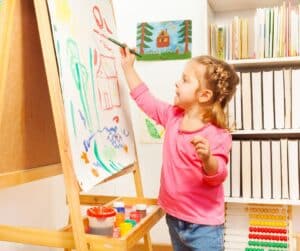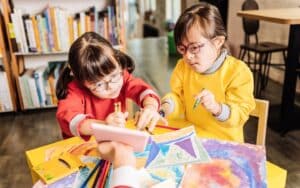While many experiences can provide benefits for your child’s development, art is one that often gets overlooked. In this article, we will explore the importance of art in language development. We will also provide some practical examples and tips about how you can incorporate art into your child’s daily routine.
The Importance of Art in Overall Child Development
Art is a form of self-expression that allows children to communicate their thoughts, emotions, and ideas in a visual and creative way. It provides a safe and non-judgmental space for them to explore their feelings, express ideas, follow a process, and experiment with different materials and techniques. By engaging in art activities, children develop important skills such as the understanding and use of language, creativity, problem-solving, critical thinking, and self-regulation, all of which are essential for their overall development.
Additionally, art can promote physical development by enhancing fine motor skills and hand-eye coordination. Children who engage in art activities often develop better control and coordination of their hands and fingers, which can lead them to improved handwriting more advanced drawing skills.

Art and Receptive Language Development
Receptive language is the ability to comprehend language. Children’s receptive language skills allow them to understand words, follow directions, and respond to questions. Art activities can support receptive language development in several ways. For example:
- Enhances Listening and Comprehension Skills: Through art instruction and discussions, children learn to listen and understand directions or narratives related to art.
- Expands Vocabulary: Participating in art activities exposes children to new vocabulary (colors, tools, position words, textures, etc) in a hands-on and meaningful way.
- Promotes Interpretation and Understanding: Engaging with art helps children in interpreting visual information and understanding non-verbal cues.
- Encourages Attention and Focus: Art activities require sustained attention and focus.
- Facilitates Recognition of Symbols and Patterns: Art exposes children to various symbols and patterns, enhancing their ability to recognize and interpret patterns in language.
Art and Expressive Language Development
Expressive language is the ability to use language to communicate thoughts, feelings, and ideas. These skills allow children to share their needs and wants, express their emotions, exchange ideas and information, and engage in social interactions with others. Art activities can support expressive language development in several ways. For example:
- Enhances Vocabulary and Descriptive Skills: Engaging in art allows children to learn new words and phrases as they describe their creations.
- Encourages Storytelling: Through creating artworks, children can learn to tell stories about their drawings or sculptures.
- Promotes Emotional Expression: Art provides a non-verbal medium for children to express their emotions and thoughts.
- Stimulates Creative Thinking: Participating in artistic activities encourages imaginative thinking, which can translate into more creative and diverse use of language and expression in everyday communication.
Art and Communication Development
Effective communication skills are essential for most of the things we do in life, and they start developing at birth. Communication skills enable children to express themselves, build relationships, and interact with the world around them.
Art activities can support communication development in several ways. For example:
- Fosters Non-Verbal Communication Skills: Art activities enable children to express ideas and emotions through visual means.

- Encourages Sharing and Collaboration: Working on art projects with others teaches children to share materials, listen to input, and collaborate effectively.
- Builds Confidence in Self-Expression: Creating and presenting art boosts a child’s confidence in expressing themselves.
- Develops Empathy and Understanding: Engaging in art with others helps children understand different perspectives.
Practical Examples and Tips for Incorporating Art into Routines
Incorporating art into your child’s daily routine can significantly enhance their language development. Here are some practical tips and examples to seamlessly integrate art into their everyday life:
- Daily Drawing Time with Descriptive Talk: Reserve a time each day for drawing or painting. Narrate and discuss what you and your child are doing.
- Story Illustration Activities: Have the child draw about a story they hear or read. Encourage them to explain their drawings. Write down what they say.
- Art Vocabulary Games: Introduce games that involve identifying and naming colors, shapes, and techniques, enhancing the child’s art-related vocabulary.
- Collaborative Art Projects with Conversation: Engage in joint art projects where parent and child can talk about what they are creating.
- Art-Based Question and Answer Sessions: While doing art, ask open-ended questions about the child’s creations. Model the answers if your child is not yet able to answer.
- Diverse Art Experiences: Introduce your child to various art materials and techniques like painting, drawing, sculpting, dot markers, tissue art, collage, etc. Name, describe, and discuss their experiences.
FAQs
1: How can doing art at home help expand my child’s vocabulary?
Engaging your child in art activities at home introduces them to new terms related to art, such as different colors, shapes, and techniques. Discussing these aspects while creating art helps your child learn and use these new words, effectively expanding their vocabulary.
2: Can my child’s storytelling skills improve through art?
Definitely. When your child creates art, they often depict stories or scenarios. Encouraging them to describe their artwork can enhance their ability to structure narratives and understand storytelling elements like sequence and plot.
3: Will art activities help my child develop better listening skills?
Yes, participating in art activities, especially when following instructions or receiving feedback, requires attentive listening. This practice is vital for understanding directions and improving overall comprehension skills.
4: How can creating art boost my child’s expressive language?
Art offers a visual means for your child to express emotions and thoughts. When they talk about their artwork and the ideas or feelings behind it, they get a chance to practice using language for self-expression, enhancing their expressive language capabilities.
5: Does working on art projects with others help my child’s language skills?
Absolutely. Collaborating on art projects involves communicating ideas, asking questions, and sharing opinions. This interaction is great for developing important language skills like articulation, negotiation, and concept explanation, essential for effective communication.
Resources
- The Artful Parent – Kids Art & Family Creativity
- An Expert on School-Based Art Therapy Explains how Art Therapy Helps Children Make Sense of the Insensible – American Art Therapy Association
- Teaching 2 and 3 Year Olds – Playful Learning Ideas for Toddlers and Preschoolers
- Using the Arts to Support English Language Learners (kennedy-center.org)‘The art of creating: Why art is important for early childhood development – MSU Extension
Conclusion
Art is a critical tool for supporting language development in children. By providing opportunities for children to learn language associated with art, express themselves, explore different materials and techniques, and communicate with others, art can help children develop essential language skills leading to more effective communication. As a parent, incorporating art into your child’s routine can be a simple and beneficial way to support your child’s language growth and development in a fun and creative way.




0 Comments